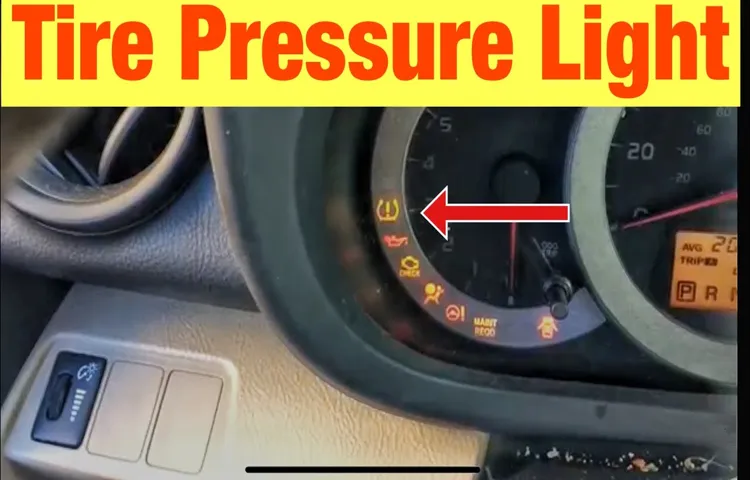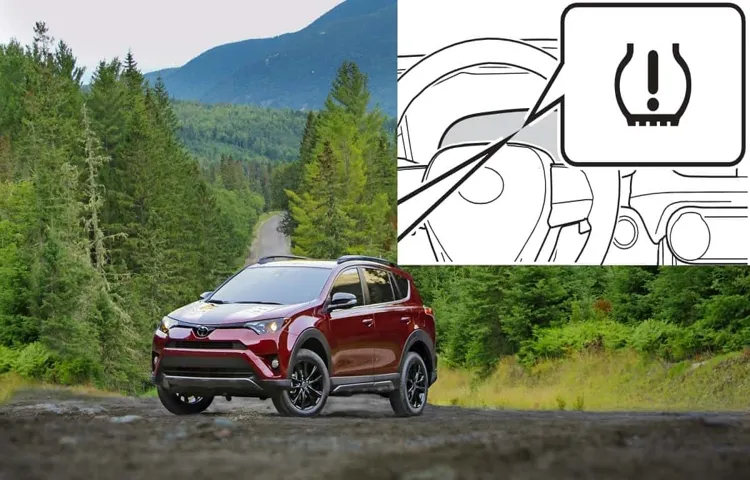Have you ever considered the impact that tire pressure can have on your Toyota RAV4’s performance and safety? Your tires are the only point of contact between your vehicle and the road, making them a critical factor in your driving experience. Proper tire pressure ensures optimal traction and handling, improves fuel efficiency, and extends tire life. So, how do you check the tire pressure on your Toyota RAV4? In this post, we’ll walk you through the process step-by-step, so you can rest assured that your vehicle is ready for any adventure on the road ahead.
Table of Contents
Why Checking Your Tire Pressure Matters
If you’re a proud owner of a Rav4, it’s important to keep your vehicle in optimal condition to ensure both safety and longevity. One crucial aspect of car maintenance is checking your tire pressure regularly. Low tire pressure not only decreases fuel efficiency but can also lead to tire damage and blowouts at high speeds.
So, how do you check tire pressure on a Rav4? The process is relatively simple and only requires a tire pressure gauge. First, unscrew the valve cap on each tire and press the gauge onto the valve stem. The gauge will provide a reading that should match the recommended tire pressure in your vehicle’s owner manual.
If the pressure is too low, add air until it reaches the proper level. Remember to check tire pressure at least once a month to ensure optimal performance and safety while driving. Keeping your tires properly inflated is a small but essential step in maintaining your Rav4 and ensuring a smooth, safe, and economical driving experience.
Improving Fuel Efficiency and Saving Money
Improving fuel efficiency is crucial for both the environment and your wallet. One simple way to achieve this is by checking your tire pressure regularly. Why does this matter? Well, when your tires are underinflated, they create more rolling resistance, which leads to decreased fuel efficiency.
In fact, studies have shown that properly inflated tires can improve gas mileage by up to 3%. That may not sound like much, but over time, it can add up to significant savings. So, make sure to check your tire pressure at least once a month, and before any long road trips.
Plus, it’s easy to do and doesn’t cost a thing! Remember, taking small steps like this can help us all make a big impact on the world around us.

Enhancing Driving Safety
Maintaining proper tire pressure is essential to ensure a safe and smooth driving experience. Yet, many drivers often overlook the importance of checking their tire pressure regularly. In fact, driving with underinflated tires can cause various safety hazards such as decreased traction, longer braking distance, and increased risk of blowouts.
It can also lead to premature tire wear, reducing your vehicle’s fuel efficiency and lifespan. So, why risk your safety and waste your money when you can easily check and maintain your tire pressure? Just grab a tire pressure gauge and follow the manufacturer’s recommended pressure level, which can be found in your vehicle’s owner manual or on a placard located on the driver’s side door jamb. Remember, a few minutes of your time can save you from potential accidents and costly repairs.
So, always keep your tires inflated to the proper pressure, and drive with confidence knowing that you are taking every step to ensure your safety and the safety of others on the road.
When to Check Tire Pressure
If you own a Toyota RAV4, it’s essential to know how to check the tire pressure regularly. Proper tire pressure not only ensures your safety but also prolongs the life of your tires. So, when should you check your tire pressure? Ideally, you should check your Toyota RAV4’s tire pressure every month.
Additionally, if you notice any changes in your vehicle’s handling or a significant drop in fuel efficiency, you should check your tire pressure immediately. Seasonal changes also affect tire pressure, so check your tires before going on a long road trip or during extreme weather conditions. Checking your tire pressure is easy and can be done with a tire pressure gauge available at any auto parts store.
All you have to do is unscrew the valve stem cap, attach the gauge to the valve stem, and read the pressure shown on the gauge. Keep the pressure within the recommended range in your vehicle’s owner’s manual, and you’re good to go! By staying on top of your tire maintenance, you’ll ensure a smooth and safe driving experience.
How Often to Check Your Tires
As a driver, one of the most important things you can do is to keep your tires properly inflated. But how often should you check your tire pressure? The answer is, at least once a month. It’s important to check them regularly because tires lose pressure over time, even if there is no visible damage or puncture.
Low tire pressure can not only lead to poor fuel efficiency, but it can also cause uneven tire wear, reduced handling, and even a blowout. It’s best to check your tire pressure when the tires are cold, before you start driving or after the car has been parked for at least an hour. Don’t rely on the visual appearance of the tire, as underinflation may not be obvious just by looking at it.
Instead, use a tire pressure gauge to determine the correct pressure for your tires (which can be found in your owner’s manual or on a sticker inside the driver’s door) and adjust accordingly. By checking your tire pressure once a month, you can ensure that your tires are properly inflated and keep your vehicle safe and efficient on the road.
Checking Your Tires After Significant Temperature Changes
Temperature changes can have a significant impact on your tire pressure, which is why it’s important to check them regularly. When the temperature drops, air molecules contract, causing the air in your tires to condense and decrease in pressure. Conversely, when the temperature rises, the air molecules expand, causing the pressure in your tires to increase.
As a result, it’s vital to check your tire pressure after significant temperature changes to ensure they’re at the appropriate pressure level. Ideally, you should check your tire pressure monthly or before long road trips, but it’s vital to make sure you check them after significant temperature changes, especially during winter months. Keep in mind that underinflated tires can significantly impact your car’s handling and fuel efficiency while overinflated tires can make your ride bumpy and increase your risk of a blowout.
So, don’t put it off any longer – grab a tire pressure gauge and check your tires today!
How to Check Tire Pressure on Your RAV4
If you own a Toyota RAV4, it’s important to regularly check your tire pressure to maintain optimal performance and safety. Luckily, checking your tire pressure is a quick and easy process. The first step is to find a tire pressure gauge, which can be found at your local auto parts store or online.
Once you have a gauge, unscrew the valve cap on your tire and press the gauge into the valve stem until you hear a hiss. Take note of the reading on the gauge and compare it to the recommended tire pressure listed on your RAV4’s door jamb or owner’s manual. If the pressure is too low, use an air compressor to fill the tire to the recommended level.
If the pressure is too high, let some air out until it reaches the appropriate pressure level. Repeat this process for all four tires, and you’ll be on your way to a smooth and comfortable ride in your RAV Remember, checking your tire pressure regularly can improve your vehicle’s handling, fuel efficiency, and even extend the life of your tires, so it’s definitely worth the effort.
Gather Your Tools: A Tire Pressure Gauge
A tire pressure gauge is one of the most important tools you should have in your car if you want to avoid any accidents or car issues while driving your RAV Checking tire pressure is an essential practice that should be done regularly to ensure that your vehicle remains safe and running smoothly on the road. The process of checking your tire pressure is simple and straightforward, all you need is a tire pressure gauge and some basic knowledge.
First, gather your tire pressure gauge and remove the cap on your tire valve. Place the gauge onto the valve stem and press it down firmly, ensuring that there is a tight seal. Then, wait for the gauge to give you a reading of your tire pressure.
The recommended tire pressure amount can be found in your owner’s manual or on a sticker located on the driver’s side doorjamb. If the pressure is too low, use an air compressor to fill up your tires to the correct pressure. Checking your tire pressure regularly not only improves your car’s performance, but it also helps you save on fuel and extends the lifespan of your tires.
Locate the Correct PSI for Your Tires
As a responsible car owner, one of the most important maintenance tasks you need to do is check your tires’ pressure regularly. Your RAV4’s tire pressure affects your vehicle’s overall performance, safety, and fuel efficiency. To check the tire pressure, you will need a tire pressure gauge, which you can buy at any auto parts store.
Start by removing the valve cap from the tire, then insert the gauge onto the valve stem. The gauge will show a reading in PSI, which stands for “pounds per square inch.” It’s crucial to check your RAV4’s owner’s manual or the sticker on the driver’s side door jamb to ensure you’re using the correct PSI level for your tires.
It’s important to note that the pressure can differ from one tire to another based on the model of your RAV4 and the load inside it. Keep in mind that underinflated tires put you at risk of a flat tire or blowout, while overinflated tires can wear out quickly and compromise your driving performance. Moreover, a quick way to prevent insufficient pressure is to fill nitrogen in your Rav4 tires.
By doing so, it will help keep an even tire pressure, meaning you won’t have to fill the tires up as often, as nitrogen diffuses at the slower rate than oxygen. Finally, it’s essential to know when to check and fill your tire pressure. The best time is when the tires are cold, which means the car hasn’t been driven for the last three hours or less than 1 mile.
Checking the tire pressure helps keep your RAV4 running well and keeps you safe on the road, making it a simple yet necessary task to prioritize.
Remove Valve Cap and Check Tire Pressure
When it comes to keeping your RAV4 running smoothly, checking your tire pressure is an essential aspect of maintenance that should never be overlooked. The first step is to remove the valve cap from the tire you want to check. Then, grab your tire gauge and place it over the valve stem.
Press down firmly to get a good seal, and then wait for the gauge to give you a reading. Ideally, you want your RAV4’s tires to be inflated to the recommended pressure listed in your owner’s manual. This will help ensure optimal performance while also maximizing fuel efficiency.
Be sure to check the pressure on all four tires, and don’t forget the spare! With just a few minutes of effort, you can help extend the life of your RAV4’s tires and keep your vehicle safe on the road.
Inflate or Deflate Tires as Needed
When it comes to taking care of your RAV4, checking tire pressure should be at the top of your maintenance list. Not only does it ensure optimal performance and fuel efficiency, but it also keeps you safe on the road. To check your RAV4’s tire pressure, you will need a tire pressure gauge (which can be purchased at your local auto parts store), a tire inflator (if you need to add air), and a little bit of time.
Simply remove the valve cap, press the gauge onto the valve, and read the measurement. If the pressure is too low, add air until it reaches the recommended pressure level (found in your owner’s manual or on the tire itself). If it’s too high, release air until it’s at the recommended pressure.
It’s important to check your RAV4’s tire pressure at least once a month, and especially before a long road trip or in extreme weather conditions. Remember, keeping your tires properly inflated not only extends their lifespan but ensures your safety on the road.
Maintaining Proper Tire Pressure
Are you wondering how to check tire pressure on your Toyota RAV4? Maintaining proper tire pressure is essential for vehicle safety, but it’s often overlooked. The recommended tire pressure can be found in your owner’s manual or on a sticker located on the driver’s side door jamb. To check your tire pressure, you’ll need a tire pressure gauge.
Simply unscrew the valve cap, attach the gauge, and press down firmly on the gauge to get a reading. If the pressure is low, use a compressor to fill the tire to the recommended PSI. Remember to check your tire pressure at least once a month, as well as before long trips or during extreme weather conditions.
Incorrect tire pressure can result in poor fuel efficiency, decreased tire life, and even dangerous blowouts while driving. Checking your tire pressure regularly is a small task that can have a big impact on your vehicle’s performance and safety.
Regularly Check and Adjust Tire Pressure
Maintaining proper tire pressure is essential for ensuring that your car operates safely and efficiently. Checking and adjusting your tire pressure regularly should be a part of your routine maintenance tasks. Tires that are over-inflated or under-inflated can lead to uneven wear, reduced fuel efficiency, decreased handling, and even blowouts.
The recommended tire pressure can be found in your car’s manual and on the sidewall of your tire. It’s important to use a reliable tire pressure gauge to ensure you have an accurate reading. If your tire pressure is too low, add air until it reaches the recommended level.
If it’s too high, release air until you reach the correct level. Properly inflated tires not only contribute to a safer driving experience, but they also extend the life of your tires and improve your overall fuel economy. So, to ensure your safety and save money in the long run, make sure to check and adjust your tire pressure regularly.
Consider Installing a Tire Pressure Monitoring System
Maintaining proper tire pressure is essential for ensuring a safe and smooth driving experience. While it may seem like a small thing, underinflated or overinflated tires can lead to decreased fuel efficiency, uneven wear, and even blowouts. That’s why it’s a good idea to consider installing a tire pressure monitoring system (TPMS) in your vehicle.
These systems use sensors to monitor the air pressure in your tires and alert you if it is too high or too low. Not only can this help prevent tire-related accidents, but it can also save you money on gas and extend the lifespan of your tires. So, if you’re looking for an easy and effective way to keep your tires in top condition, a TPMS might be just what you need.
Final Thoughts
In conclusion, checking the tire pressure on your Rav4 is an important task that should be performed regularly. It not only ensures optimal driving performance but also helps prevent accidents and extends the lifespan of your tires. Remember to always refer to the owner’s manual for the recommended tire pressure and use a reliable tire pressure gauge.
It’s a simple task that can be done at home or at a gas station and only takes a few minutes. By taking the time to properly check your tire pressure, you’ll save money on fuel and avoid any unnecessary and potentially dangerous mishaps on the road. So, don’t neglect this essential maintenance task and keep your Rav4 performing at its best.
Conclusion
In conclusion, checking your Rav4’s tire pressure is as easy as 1-2- With the right tools and a little bit of elbow grease, you can ensure a safe and optimal driving experience every time you hit the road. And if you’re feeling a little unsure, just remember: the only thing worse than a flat tire is a flat joke.
So grab your pressure gauge and get rolling, to ensure your Rav4 rides smoothly!”
FAQs
Why is it important to regularly check tire pressure on a Toyota RAV4?
Regularly checking tire pressure on your Toyota RAV4 ensures optimal handling, fuel efficiency, and extends the life of your tires.
How often should I check the tire pressure on my Toyota RAV4?
It is recommended to check tire pressure on your Toyota RAV4 at least once a month and before long road trips.
What is the recommended tire pressure for a Toyota RAV4?
The recommended tire pressure for a Toyota RAV4 can be found in the owner’s manual or on the driver-side door jamb.
What tools do I need to check the tire pressure on my Toyota RAV4?
You will need a tire pressure gauge and an air compressor or public air station with a pressure gauge.
What should I do if my Toyota RAV4’s tire pressure is low?
Add air to your tires until they reach the recommended tire pressure. Do not overinflate the tires.
Can I check tire pressure on my Toyota RAV4 myself?
Yes, checking tire pressure on your Toyota RAV4 is a simple task that can be done at home.
What happens if I continuously drive with low tire pressure on my Toyota RAV4?
Continuously driving with low tire pressure on your Toyota RAV4 can lead to decreased fuel efficiency, premature tire wear, and potentially dangerous blowouts.



